Template:Pic of the day/Archive1
The images and text below were previously been featured on Wikipedia:Picture of the day. For an image-only archive without the text, see Template:Pic of the day/Image archive. To use the pic of the day on your own user or talk page, type {{pic of the day}} or {{POTD}}. For more recent images of the day, see Template:Pic of the day/Archive.
 Mickey Mouse, Saturday, 14 August, 2004
Mickey Mouse, Saturday, 14 August, 2004
A medieval image resembling the cartoon character Mickey Mouse was discovered on November 14, 2002 during restoration of a church's outside wall in the town of Malta in Austria. It is part of a 14th-century fresco depicting Saint Christopher of the Roman Catholic Church, who is often shown accompanied by fabulous creatures. Photo credit: Unknown 14th century source
 City Hall, London, Friday 13 August, 2004
City Hall, London, Friday 13 August, 2004
City Hall in London is the headquarters of the Greater London Authority, and stands on the south bank of the River Thames near to Tower Bridge. The building was designed by Sir Norman Foster and opened in July 2002. It has an unusual bulbous shape, intended to reduce the building's surface area and thus improve energy efficiency. City Hall was constructed on a site formerly occupied by wharves serving the Pool of London (a stretch of the River Thames). Photo credit: ChrisO
![]() Santa Cruz Mountains, Thursday 12 August, 2004
Santa Cruz Mountains, Thursday 12 August, 2004
Skyline Boulevard runs through the Santa Cruz Mountains, here near Palo Alto, California. The Santa Cruz Mountains, part of the Coast Ranges, are a mountain range in central California. They form a ridge along the San Francisco Peninsula, south of San Francisco, separating the Pacific Ocean from San Francisco Bay and the Santa Clara Valley, and continuing south, bordering Monterey Bay and ending at the Salinas Valley. Photo credit: Jawed Karim
 Mackerel sky, Wednesday 11 August, 2004
Mackerel sky, Wednesday 11 August, 2004
A mackerel sky is an indicator of moisture and instability at high levels. If the lower atmosphere is stable and no moist air moves in, the weather will most likely remain dry. However, moisture at lower levels combined with temperature instability can lead to spectacular thunderstorms should the rising moist air reach this layer. In weather lore, a mackerel sky portends changeable weather. Photo credit: Denni Windrim
 Machu Picchu, Tuesday 10 August, 2004
Machu Picchu, Tuesday 10 August, 2004
Machu Picchu is a well preserved Pre-Columbian town located on a high mountain ridge above the Urubamba valley in modern-day Peru. It is thought the city was built by the Inca emperor Pachacuti starting in about 1440 and was inhabited until 1532. The city was re-discovered in 1911 by Hiram Bingham. This World Heritage Site is a popular tourist attraction. Photo credit: Chmouel Boudjnah
 Central Arizona Project Aqueduct, Monday 9 August, 2004
Central Arizona Project Aqueduct, Monday 9 August, 2004
The Central Arizona Project Aqueduct is a diversion canal in Arizona in the United States. The aqueduct diverts water from the Colorado River from Lake Havasu City into central and southern Arizona. The Central Arizona Project is a multipurpose water resource development and management project that was designed to provide water to nearly one million acres (4000 km2) of Indian and non-Indian irrigated agricultural land areas as well as municipal water for several Arizona communities. Photo credit: US Bureau of Reclamation
 New Scotland Yard, Sunday 8 August, 2004
New Scotland Yard, Sunday 8 August, 2004
New Scotland Yard, located at Broadway in Westminster, is the headquarters of the Metropolitan Police Service who are responsible for policing Greater London. The name derives from its original location on a street off Whitehall called Great Scotland Yard. The exact origins of this name are unknown, though a popular explanation is that it was the former site of the residence of the Scottish kings or their ambassadors when staying in England. Photo credit: ChrisO
 Thunderstorm, Saturday, 7 August, 2004
Thunderstorm, Saturday, 7 August, 2004
A thunderstorm is a form of severe weather involving lightning and thunder. Thunderstorms have had a lasting and powerful influence on mankind. Romans thought them to be battles waged by Jupiter. Thunderstorms were associated with the Thunderbird, held by Native Americans to be a servant of the Great Spirit. Photo credit: John Kerstholt
Fennec Fox, Friday 6 August, 2004
The Fennec Fox is a small fox found in the desert of Northern Africa. The fennec is the smallest canid, only weighing up to 1.5 kg. The fennec is nocturnal and hunts for rodents, insects, lizards, birds and eggs at night. The fennec is rare and is not often seen. It is often hunted by humans, even though the fox does not cause any harm to human interests. Photo credit: Ralf Schmode
 London by night, 5 August, 2004
London by night, 5 August, 2004
London is the capital of the United Kingdom and of England. The city of Londinium was founded by the Romans on the north bank of the River Thames in around 50 AD. By the 18th century London was the biggest city in the world. It was the most populous city in the world from 1825 until 1925, when it was overtaken by New York City. Photo credit: NASA
 Schlern, 4 August, 2004
Schlern, 4 August, 2004
The Schlern is a 2,563 m high mountain of the Dolomites in South Tyrol, Italy. The Dolomites are a section of the Alps in northern Italy. The name Dolomites is derived from the French mineralogist Deodat de Dolomieu who was the first to describe the mineral Dolomite which is responsible for the characteristic shapes of these great limestone mountains. Photo credit: Fantasy
 Halong Bay, 3 August, 2004
Halong Bay, 3 August, 2004
Halong Bay (Vịnh Hạ) is a body of water in north Vietnam in the Gulf of Tonkin near the border with China. Its name means "Bay of the Descending Dragon" in Vietnamese. The bay consists of a dense cluster of 1969 limestone monolithic islands, each topped with thick jungle vegetation, which rise spectacularly from the ocean. Photo credit: David Stewart
Darby and Joan, Monday August 2, 2004
Royal Doulton Darby and Joan figurines. "Darby and Joan" is a term used to describe a happily married couple. In England, clubs for senior citizens are appropriately called Darby and Joan Clubs. The first mention of John Darby and his wife Joan is believed to be in a poem by Henry Woodfall in 1735. At that time Woodfall was apprentice to Darby, a printer from the town of Bartholemew Close. Photo credit: Paul Darby
 Yellowstone National Park, 1 August, 2004
Yellowstone National Park, 1 August, 2004
Yellowstone National Park is a United States National Park located in the states of Idaho, Montana, and Wyoming. Yellowstone is the first and oldest national park in the world. The park is famous for its geothermal features and is home to grizzly bears, wolves, bison and elk. Photo credit: Daniel Mayer
 National Gallery, Saturday 31 July, 2004
National Gallery, Saturday 31 July, 2004
The National Gallery at night, illuminated for an event to promote the launch of a Pepsi commercial. The National Gallery in London is an art gallery designed by William Wilkins. It holds part of the National Collection, particularly Western European art from 1250 to 1900. The collection of 2300 paintings belongs to the British public. Photo credit: Michael Reeve
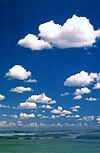 Weather lore, Friday 30 July, 2004
Weather lore, Friday 30 July, 2004
Weather lore, the informal folklore related to the prediction of the weather, suggests that the cumulus humilis clouds in this sky indicate a good day ahead. Such clouds show there is very little convection in the lower atmosphere, and the fact that it is well-formed indicates light winds at low levels. There is no cloud aloft, and thus no moisture or stable conditions or both. The cumulus congestus on the horizon suggests showers may be possible three or four hours from now, at the earliest, but chances are good it will remain a pleasant day through until the evening. Photo credit: Denni Windrim
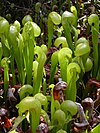 Darlingtonia, Thursday 29 July, 2004
Darlingtonia, Thursday 29 July, 2004
Darlingtonia (Darlingtonia californica), also called the California Pitcher plant or Cobra Lily, is a carnivorous plant in the family Sarraceniaceae. Darlingtonia is native to California and Oregon and grows in bogs and seeps. The name Cobra Lily is from the resemblance of the tubular leaf to a rearing Cobra, complete with "fangs". The genus Darlingtonia is monotypic. Photo credit: Daniel Keshet
 Icefish, Wednesday 28 July, 2004
Icefish, Wednesday 28 July, 2004
Icefish are a type of Antarctic fish belonging to various families, including the Channichthyidae family. They have no haemoglobin and their blood is transparent. They feed on krill, copepods, and other fish. Icefish rely on well-oxygenated water and absorb oxygen directly through the skin as they lack red blood cells. Photo credit: Uwe Kils
Mount Cook, Tuesday 27 July, 2004
Mount Cook, a peak in the Southern Alps is the highest mountain in New Zealand. Mount Cook is also known as Aoraki, meaning "Cloud Piercer" in the Kai Tahu dialect of the Maori language. The mountain is located within the Aoraki/Mount Cook National Park and was formally declared one of the United Nations World Heritage Parks in 1953. Photo credit: User:Dynabee
 Tawaret, Monday 26 July, 2004
Tawaret, Monday 26 July, 2004
Tawaret was a popular deity in ancient Egyptian mythology. She was a household deity who protected women during pregnancy and childbirth, in conjunction with another deity, Bes. Tawaret was depicted as an amalgam of human and animal with the head of a hippopotamus,the arms and legs of a lion, the back and tail of a crocodile, and the breasts and stomach of a pregnant woman. Photo credit: ChrisO
 Pin tumbler lock, Sunday 25 July, 2004
Pin tumbler lock, Sunday 25 July, 2004
The pin tumbler lock is a lock mechanism that utilizes a group of pins of varying lengths to prevent opening the lock without the correct key. Pin tumblers are most commonly employed in cylinder locks, but may also be found in tubular or radial locks. When the correct key is inserted, the gaps between the key pins (red) and driver pins (blue) align with the edge of the plug (yellow). Photo credit: Eric Pierce
 Four-stroke cycle, Saturday 23 July, 2004
Four-stroke cycle, Saturday 23 July, 2004
The four-stroke cycle of an internal combustion engine is the cycle most commonly used for automotive and industrial purposes today, including cars, trucks, and generators. The cycle was invented by Nikolaus Otto in 1876, and is also called the Otto cycle. The cycle is characterized by four strokes, or straight movements in a single direction, of the piston. Photo credit: Eric Pierce
 Zootomical terms of location, Friday 23 July, 2004
Zootomical terms of location, Friday 23 July, 2004
Zootomical terms of location differ from the terminology used in human anatomy. In animals, the head end is called the "cranial end" and the tail end is the "caudal end". The side of the body normally oriented upwards is the "dorsal" side; the opposite side, typically the one closest to the ground when walking on all legs, swimming or flying, is the "ventral" side. Photo credit: Jonathan Merritt
 Geisha, Thursday 22 July, 2004
Geisha, Thursday 22 July, 2004
Women dressed as geisha in Kyoto, Japan. They are wearing traditional kimonos and geta. Geisha (芸者) are traditional Japanese artist-entertainers. Geisha were very common in the 18th and 19th centuries, and are still in existence today, although their numbers are dwindling. The geisha tradition evolved from the taikomochi or hōkan, similar to court jesters. Geisha were traditionally trained from young childhood although modern geisha begin their training, which remains extremely long and difficult, at much older age. Photo credit: Michael Reeve
 Water Buffalo, Wednesday 21 July, 2004
Water Buffalo, Wednesday 21 July, 2004
The Water Buffalo is a very large ungulate. It probably survives in the wild in India, Nepal, Bhutan and Thailand; is very widespread as a domestic animal in Asia, South America. North Africa and Europe; and is feral in northern Australia. Wild-living populations of Water Buffalo also exist in much of South-east Asia but their origin is uncertain: they may be the descendants of wild Water Buffalo, formerly domesticated ferals, or a mixture of both. The population of wild Water Buffalo has become very sparse. Photo credit: Chmouel Boudjnah
 Planet Mars, Tuesday 20 July, 2004
Planet Mars, Tuesday 20 July, 2004
Mars, the fourth planet from the Sun, is named after the Roman god of war because of its blood red color. Mars has two small, oddly-shaped moons, Phobos and Deimos, named after the sons of the Greek god Ares. At some point in the future Phobos will be broken up by gravitational forces. The atmosphere on Mars is 95% carbon dioxide. In 2003 methane was also discovered in the atmosphere. Since methane is an unstable gas, this indicates that there must be (or have been within the last few hundred years) a source of the gas on the planet. Photo credit: NASA
 Bryce Canyon National Park, 19 July, 2004
Bryce Canyon National Park, 19 July, 2004
Bryce Canyon National Park is distinctive due to its unique geological structures, called hoodoos. In winter, most birds in the park migrate, but jays, ravens, nuthatches, eagles, and owls stay. The Mule Deer, Mountain Lion, and coyotes will migrate to lower elevations. Ground squirrels and marmots pass the winter in hibernation. Photo credit: National Park Service
![]() San Francisco Bay Area, Sunday 18 July, 2004
San Francisco Bay Area, Sunday 18 July, 2004
The Skyline Boulevard in the San Francisco Bay Area stretches through the Santa Cruz Mountains, here near Palo Alto, California. Three large cities dominate the San Francisco Bay Area; San Francisco, San Jose, and Oakland. As well as constituting one of the world's greatest metropolitan areas, the Bay Area includes some exceptional natural coastal and rural landscape. It includes significant national parks such as the Point Reyes National Seashore and a large number of state parks. Photo credit: Jawed Karim
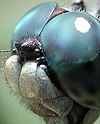 Compound eye of a dragonfly, Saturday 17 July, 2004
Compound eye of a dragonfly, Saturday 17 July, 2004
A compound eye is a visual organ found in certain arthropods. The compound eye consists of between 12 and 1,000 ommatidia, little dark/bright sensors. The image perceived by the arthropod is "recalculated" from the numerous ommatidia which point in slightly different directions. In contrast to other eye types, there is no central lens or retina. Though the resulting image is poor in resolution, it can detect quick movements and, in some cases, the polarization of light. Dragonflies have about 30,000 facets to their compound eyes, giving them nearly a 360° field of vision. Photo credit: David L. Green
Sistine Chapel, Friday 16 July, 2004
The Sistine Chapel is a religious chapel and one of the most famous artistic treasures of the Vatican, built between 1475 and 1483, in the time of Pope Sixtus IV della Rovere. The chapel is known worldwide both for being the hall in which conclaves and other official ceremonies are held, including some papal coronations, and for having been decorated by Michelangelo. The subjects of the pictures were historical religious themes. Michelangelo was employed to paint only 12 figures, the Apostles, but when the work was finished there were more than 3,000. Photo credit: Adrian Pingstone using a artchive.com source
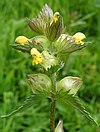 Yellow rattle, Thursday 15 July
Yellow rattle, Thursday 15 July
Yellow rattle (Rhinanthus minor) is a flowering plant in the family Scrophulariaceae. This family comprises 220-300 genera and 4000-4500 species. The family has a cosmopolitan distribution, with the majority found in temperate areas, including tropical mountains. Other members of the family include Digitalis, Linaria and Verbascum. Yellow rattle is a semi-parasitic plant that gains some of its nutrients from the roots of neighbouring plants. The name refers to the seedpods, which contain loose, rattling seeds when ripe. Photo credit: sannse
![]() Painter's algorithm, Wednesday 14 July.
Painter's algorithm, Wednesday 14 July.
The painter's algorithm is one of the simplest solutions to the visibility problem in 3D computer graphics. When projecting a 3D scene onto a 2D plane, it is at some point necessary to decide which polygons are visible and which are hidden. The distant mountains are painted first, followed by the closer meadows; finally, the closest objects in this scene - the trees - are painted. For detailed scenes, the painter's algorthm generally proves to be a slow solution. Photo credit: Fredrik
 Notre-Dame, Tuesday 13 July.
Notre-Dame, Tuesday 13 July.
View of Paris from the Notre-Dame showing the River Seine and the Eiffel Tower. The Notre-Dame de Paris is a gothic cathedral on the eastern half of the Île de la Cité in Paris, France. The cathedral is probably best known from Victor Hugo's novel, The Hunchback of Notre Dame, which was first published in 1831. Photo credit: Michael Reeve
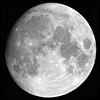 Moon, Monday 12 July.
Moon, Monday 12 July.
The Moon is the only natural satellite of Earth. During the ancient period, it was not uncommon for cultures to believe that the Moon died each night, thus descending into the underworld. As late as the 1920s (or so), it was believed that the Moon might have a breathable atmosphere. In 1969, Neil Armstrong and Buzz Aldrin became the first humans to land on the Moon. Photo credit: Michael K. Fairbanks
 Mad scientist, Sunday 11 July.
Mad scientist, Sunday 11 July.
A mad scientist is a stock character, often villainous, who appears in fiction as a scientist who is insane or eccentric. He is usually working with some utterly fictional technology in order to forward his evil schemes. Recent mad scientist depictions are often satirical and humorous, and some are actually protagonists, such as Dexter in the cartoon series Dexter's Laboratory. Photo credit: J.J. McCullough
 Brisbane, Saturday 10 July.
Brisbane, Saturday 10 July.
Brisbane at night. Brisbane is the capital city of the state of Queensland, Australia. It is situated in the southeast corner of Queensland and straddles the Brisbane River. The city is named after Sir Thomas Brisbane, a soldier and colonial administrator born in Ayrshire, Scotland. Photo credit: Gary Curtis
 Lincoln Memorial, Friday 9 July.
Lincoln Memorial, Friday 9 July.
The focus of the Lincoln Memorial is this sculpture of Abraham Lincoln, seated. Daniel Chester French studied many of Mathew Brady's photographs of Lincoln, and depicted the president as worn and pensive, gazing eastwards down the Reflecting Pool at the capital's starkest emblem of the Union, the Washington Monument. One hand is clenched, the other open. Beneath his hands, the Roman fasces, symbols of the authority of the Republic, are sculpted in relief on the seat. Photo credit: Raul654
 Passchendaele, Thursday 8 July.
Passchendaele, Thursday 8 July.
Soldiers of an Australian 4th Division field artillery brigade on a duckboard track passing through Chateau Wood, near Hooge in the Ypres salient, October 29, 1917. The photo was taken in the vicinity of the Battle of Passchendaele, also known as the Third Battle of Ypres, which was one of the major battles of World War I. Photo credit: James Francis Hurley
 Madrid metro, Wednesday 7 July.
Madrid metro, Wednesday 7 July.
The Madrid metro is the large metro system serving Madrid, the capital of Spain. It is one of the largest metro systems in the world, despite Madrid having a population of only four million. The metro opened in 1919 under the direction of the Compañía de Metro Alfonso XIII. Metro stations served as air raid shelters during the Spanish Civil War. Photo credit: Montrealais
Bolzano (Bozen), Tuesday 6 July.
Bolzano (Bozen) is a town in the Trentino-Alto Adige/Südtirol region of Italy. It is the capital of the Italian/German/Ladin speaking Autonomous Province of Bolzano-Bozen, officially trilingual. The province is almost completely mountainous, and is extended on the Adige valley north of the town of Salorno (Salurn). Photo credit: Roland Wolf
 Queenstown, New Zealand, Saturday 3 July.
Queenstown, New Zealand, Saturday 3 July.
The Remarkables and Lake Wakatipu from Queenstown. The Remarkables are a 540 acre (2.2 km2) mountain ski field located south of Queenstown, New Zealand. The other ski fields in Queenstown are Cardrona, Coronet Peak, and Treble Cone. Queenstown is a resort town in South Island and is surrounded by the Southern Alps. Photo credit: Tiles
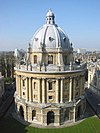 Radcliffe Camera, Tuesday 29 June.
Radcliffe Camera, Tuesday 29 June.
The Radcliffe Camera in Oxford, England was built by James Gibbs between 1737 and 1749 to house the Radcliffe Science Library. The building was funded by a £40,000 bequest from John Radcliffe. After the Radcliffe Science Library eventually moved into another building, the Radcliffe Camera became a reading room of the Bodleian Library. It now holds books from the English and History collection. Photo credit: Michael Reeve
 USS Port Royal (CG-73), Saturday 26 June.
USS Port Royal (CG-73), Saturday 26 June.
The USS Port Royal (CG-73) is a United States Navy guided missile cruiser, the last to be constructed in the 20th century, and the first cruiser to integrate women into the crew. The ship was deployed in 1996 as part of the Nimitz (CVN-68) battle group. Photo credit: Christopher Mobley
 Gold Coast, Australia, Friday 25 June.
Gold Coast, Australia, Friday 25 June.
The Gold Coast is a coastal region approximately 70 kilometres south of Brisbane, Australia that, over the past 50 years, has coalesced from a collection of scattered villages into a city of approximately 400,000 people. The subtropical climate, attractive surf beaches, and savvy marketing have attracted millions of tourists. Photo credit: Gary Curtis
 Weather lore, Thursday 24 June.
Weather lore, Thursday 24 June.
Red sky at night, sailors delight. Red sky in the morning, sailors take warning. A red sky occurs primarily at sunrise or sunset, when the sun's rays are passing through the greatest thickness of atmosphere. In weather lore, morning red skies are a good indicator of coming rain, evening red skies usually indicate clearing conditions. Photo credit: Denni Windrim
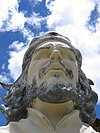 Che Guevara, Wednesday 23 June.
Che Guevara, Wednesday 23 June.
Che Guevara statue at the site of his death in Bolivia. Che Guevara was an Argentine-born Marxist revolutionary and Cuban guerrilla leader. Guevara was a member of Fidel Castro's 26th of July Movement, which seized power in Cuba in 1959. After the revolution Guevara became second only to Fidel Castro in the new government of Cuba. Photo credit: Augusto Starita
 English Springer Spaniel, Tuesday 22 June .
English Springer Spaniel, Tuesday 22 June .
Spot Fetcher. U.S. President George W. Bush's dog. The English Springer Spaniel is a gun dog used for flushing and retrieving game. This spaniel is an older breed, appearing in paintings as early as the 1600s. It is possibly the ancestor of most modern spaniels; Springer spaniels and cocker spaniels were not recognized as separate breeds until the 1800s. Photo credit: Paul Morse
 Cell growth, Monday 21 June .
Cell growth, Monday 21 June .
Three types of cell reproduction; Binary fission and reproduction involving mitosis or meiosis. In the context of reproduction of living cells, "cell growth" refers to the "growth in cell numbers by means of cell reproduction." During cell reproduction one cell (the "parental" cell) divides to produce daughter cells. In other contexts, "cell growth" refers to increases in cell size. Photo credit: John Schmidt
 Roundabout, Sunday 20 June.
Roundabout, Sunday 20 June.
A diagram of movement within a roundabout in a country where traffic drives on the left. A roundabout is a type of road junction, or traffic calming device, at which traffic streams circularly around a central island after first yielding to the circulating traffic. Unlike with traffic circles, vehicles on a roundabout have priority over the entering vehicle, parking is not allowed and pedestrians are usually prohibited from the central island. Photo credit: Fredrik and Mintguy
 Parliament of Canada, Saturday 19 June.
Parliament of Canada, Saturday 19 June.
Centre Block and Library of the Parliament of Canada. The Parliament of Canada is housed in a complex on Parliament Hill, on the banks of the Ottawa River in downtown Ottawa, in a Gothic revival suite of buildings. The best known is the Centre Block, with its prominent Peace Tower, a national symbol. The richly decorated interior of the centre block contains allegorical scenes. Photo credit: Montréalais
 High Cross, Friday 18 June.
High Cross, Friday 18 June.
High Cross at the Rock of Cashel in Ireland. A High Cross is a standing cross with a circle, made of stone and often richly ornamented. High Crosses exist in Celtic parts of Britain and Ireland; the Irish High Cross has become more famous because of its distinctive shape (the ringed Celtic Cross) and the amount and quality of decoration. The Rock of Cashel, also known as Cashel of the Kings, is situated in county Tipperary in Ireland. Photo credit: Chmouel Boudjnah
 433 Eros, Thursday 17 June.
433 Eros, Thursday 17 June.
The asteroid 433 Eros was named after the Greek god of love Eros. This S-type asteroid is the second-largest near-Earth asteroid. This image shows the view looking from one end of the asteroid across the gouge on its underside and toward the opposite end. Photo credit: NASA

Chèche. Headgear is the name given to any element of clothing which is worn on one's head. A "chèche" or "tagelmoust" turban is a form of headgear worn by men and women in Saharan Africa as protection against wind and sand. Photo credit: Anthere
 Circlestrafing, Tuesday 15 June.
Circlestrafing, Tuesday 15 June.
Circlestrafing. In video games, particularly in first-person shooters, circlestrafing is the technique of moving around a target in a circle while facing it. It allows a player to fire continuously at a target while simultaneously dodging attacks. In this diagram, the blue player circlestrafes around his red adversary, firing continually as he does so. Red, unable to keep track of the moving blue, misses with most shots. Blue will prevail. Photo credit: Fredrik
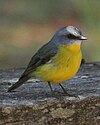 Eastern Yellow Robin, Monday 14 June.
Eastern Yellow Robin, Monday 14 June.
The Eastern Yellow Robin (Eopsaltria australis) is a common resident of coastal and sub-coastal eastern Australia, from the extreme south-east corner of South Australia through most of Victoria and the western half of New South Wales and north as far as Cooktown, though tropical northern Queensland birds are mainly restricted to the cool heights of the Great Dividing Range. Photo credit: Tony Wilson
 Earth at night, Sunday 13 June.
Earth at night, Sunday 13 June.
Earth at night. Earth is the third planet outward from the Sun. The northernmost settlement on Earth is Alert, Ellesmere Island, Canada. The southernmost is the Amundsen–Scott South Pole Station, in Antarctica. Photo credit: NASA and NOAA
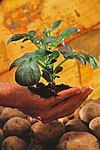 Potato plant, Saturday 12 June.
Potato plant, Saturday 12 June.
Potato plant. Potato plants are low-growing and have white flowers with yellow stamens. They grow best in cool, moist climates such as Maine, Idaho, New Brunswick, Prince Edward Island, Germany, Russia, and Poland, though they are widely adaptable and are grown on a small scale in most temperate regions. Common varieties of potatoes do not produce seeds; the flowers are sterile. Instead, they are propagated by planting pieces of existing tubers, cut to include at least one eye. Confusingly, these pieces are called "seed potatoes". Photo credit: Agricultural Research Service
 Champs-Élysées, Friday 11 June.
Champs-Élysées, Friday 11 June.
Looking east along the Champs-Élysées from the top of the Arc de Triomphe. The Champs-Élysées is a broad avenue in the French capital Paris. With its cinemas, cafés, and luxury specialty shops, the Champs-Élysées is one of the most famous streets in the world. The name refers to the Elysian Fields, the kingdom of the dead in Greek mythology. Photo credit: Michael Reeve
 USS Iowa (BB-61), Thursday 10 June.
USS Iowa (BB-61), Thursday 10 June.
The USS Iowa firing during target exercises near Vieques, Puerto Rico. USS Iowa (BB-61), the lead ship of her class of dreadnought battleship, was the fourth United States Navy ship with this name. Iowa was launched on 27 August 1942. As of 21 April 2001, Iowa is part of the Reserve Fleet at Suisun Bay, San Francisco. Photo credit: Naval Historical Center
![]() The London Eye, Wednesday 9 June.
The London Eye, Wednesday 9 June.
The London Eye observation wheel. The London Eye is the largest observation wheel (a type of Ferris wheel) in the world. It stands 135 metres (443 ft) high on the South Bank of the River Thames near the Houses of Parliament in Lambeth, London, England, close to Westminster Bridge. The Eye has become a major landmark and tourist attraction since its official opening on December 31, 1999 Photo credit: Fantasy
 Yarra River, Tuesday 8 June.
Yarra River, Tuesday 8 June.
The Yarra River is a river in southern Victoria, Australia. Its lower reaches travel through central Melbourne. It is approximately 242 kilometres in length, and its mean annual flow is 718,000 megalitres. Like virtually all of Australia's rivers, annual flows vary greatly due to the effect of El Nino. The river's source is a series of swamps on Mount Baw Baw. Some of the Yarra's major tributaries include the Plenty River, and the Merri Creek. Photo credit: Russell Degnan
 Geography of the Philippines, Sunday 6 June.
Geography of the Philippines, Sunday 6 June.
Physical map of physical geography of the Philippines. The Philippines is an archipelago of 7,107 islands. The largest of these islands is Luzon. The islands are volcanic in origin, being part of the Ring of Fire, and are mostly mountainous. The highest point in the country is the peak of Mt. Apo in Mindanao, which is 2,954 m above sea level. Most of the islands used to be covered in tropical rainforests, however, due to illegal logging, the forest cover has been reduced to less than 10% of the total land area. Photo credit: Seav
 Bumblebee, Saturday 5 June.
Bumblebee, Saturday 5 June.
The bumblebee is a flying insect of the genus Bombus in the family Apidae. Like the common honeybee, of which it is a distant relative, the bumblebee feeds on nectar and gathers pollen to feed its young. Bumblebees tend to be larger than other members of the bee family. Most, but not all, bumblebee species are gentle. Bumblebees are the pollinator of choice for modern greenhouse tomatoes and some other crops. Photo credit: Mark Burnett
 Dust storm, Friday 4 June.
Dust storm, Friday 4 June.
Dust storm, Spearman, Texas, 1935. A dust storm is a meteorological phenomenon common in arid and semi-arid regions. The dust picked up in such a storm can be carried thousands of kilometers: Sahara dust storms influence plankton growth in the western Atlantic Ocean. Photo credit: US NOAA
 Epicyclic gearing, Thursday 3 June.
Epicyclic gearing, Thursday 3 June.
Epicyclic gears. A gear is a toothed wheel designed to transmit torque to another gear or toothed component. Epicyclic gearing is a system consisting of outer gears, typically mounted on a movable arm, rotating about a central gear. Photo credit: Wapcaplet
![]() Tamar Bridge, Wednesday 2 June.
Tamar Bridge, Wednesday 2 June.
A panoramic photograph taken from the Tamar Bridge between Cornwall and Devon, England, showing the Tamar Valley and the Royal Albert Bridge. The Tamar Bridge was the longest suspension bridge in the UK when it opened in 1961. In 2001 it became the world's first suspension bridge to be widened using cantilevers. The Royal Albert Bridge was designed by Isambard Kingdom Brunel. Photo credit: Tony Tapp
 Butterfly, Tuesday 1 June.
Butterfly, Tuesday 1 June.
Blue Morpho butterfly (Morpho menelaus). A butterfly is a flying insect of the order Lepidoptera. As Lepidoptera, butterflies have four wings, but unlike moths, the fore and hindwings are not hooked together, permitting a more graceful flight. Unlike most insects, butterflies do not experience a nymph period, but instead go through a pupal stage. Photo credit: Gregory Phillips.
 Peppermint, Monday May 31.
Peppermint, Monday May 31.
Peppermint and Corsican mint plant. Peppermint (Mentha x piperita) is a sterile hybrid mint with a high menthol content, often used in tea and confectionery. Peppermint is the oldest and most popular flavour. Photo credit: Michael Thompson
 Villain, Sunday May 30.
Villain, Sunday May 30.
Snidely Whiplash, an example of a stereotypical villain. A villain is a bad person, especially in fiction. Villains are the fictional characters, or perhaps fictionalized characters, in drama and melodrama who work to thwart the plans of the hero. There are many villain stereotypes. In the era before sound in motion pictures villains had to appear very "visually" sinister, and thus many villain stereotypes were born. Photo credit: J.J. McCullough
 Geyser, Saturday May 29.
Geyser, Saturday May 29.
Strokkur geyser exploding. A geyser is a special type of hot spring that erupts periodically, ejecting a column of hot water and steam into the air. Strokkur geyser is found in Geysir in the Haukadalur valley, Iceland.
Photo credit: Hannah Beker
Sainte Jeanne d'Arc Church, Friday May 28 .
Sainte Jeanne d'Arc Church at night. Sainte Jeanne d'Arc Church is a Catholic church in Nice, France which is noticeable for its original architecture. The church was built between 1926 and 1933 by the architect Jacques Dror in reinforced concrete. The style was influenced by Art nouveau. Photo credit: Ericd
Lift Engineering chairlift, Wednesday/Thursday May 26/27.
Towers and chairs on a Yan triple lift. Lift Engineering, was formerly a major ski lift manufacturer. Founder Jan Kunczynski was credited with being the first manufacturer of ski lifts to incorporate aesthetics into the design of his equipment. Photo credit: Vancouverguy
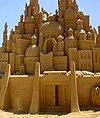 Sand castle, Tuesday May 25.
Sand castle, Tuesday May 25.
A sand castle is a type of sand sculpture which resembles a miniature building, often a castle. Sand castles are typically made on beaches with wet fine sand and, optionally, tools such as shovels and buckets and reinforcers such as wood, usually by children, but also by adults who engage in sand sculpture contests, in which the goal is to create large and complex structures which do not appear to be constructed purely from sand. Photo credit: Guy King
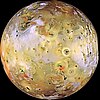 Io moon, Monday May 24.
Io moon, Monday May 24.
Io moon taken by NASA's Galileo probe. This image shows two volcanic eruptions. The one on the horizon is 140 km high, the other is 75 km high. Io is the innermost of the four Galilean moons of Jupiter. It is named after Io, one of Zeus's many love interests in Greek mythology. Photo credit: NASA
 Black Puma in Belize, Friday May 21.
Black Puma in Belize, Friday May 21.
The puma (Puma concolor, or Felis concolor) is a type of large hunting cat found in North and South America. It is also known by the regional names of cougar, mountain lion, panther, catamount and painted cat. Pumas have the largest distribution range of any New World land animal, spanning 110 degrees of latitude. Photo credit: Belizian

Zabriskie Point is an area in Death Valley National Park noted for its beautiful erosional landscape. It is called a badlands due to its difficult to traverse topography. Photo credit: Daniel Mayer
 Gallium, Tuesday May 18.
Gallium, Tuesday May 18.
Crystals of 99.999% gallium. The chemical element gallium is a rare, soft silvery metallic poor metal. It occurs in trace amounts in bauxite and zinc ores. Gallium is notable for its stunning silvery color and its solid metal fractures conchoidally like glass. Photo credit: Foobar
 Sydney Opera House, Monday May 17.
Sydney Opera House, Monday May 17.
The Sydney Opera House in Sydney, New South Wales , Australia. Situated on Bennelong Point at Sydney Harbour, the Sydney Opera House is one of the most distinctive and famous 20th-century buildings, and one of the most famous performing arts venues in the world. Photo credit: Chmouel
 Abbey of Senanque, Sunday May 16.
Abbey of Senanque, Sunday May 16.
Abbey of Senanque, located in France, Provence, Vaucluse, Gordes village. An abbey is a Christian monastery or convent, under the government of an Abbot or an Abbess, who serve as the spiritual father or mother of the community. Photo credit: Greudin
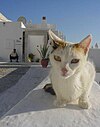 Cat in Greece, Saturday May 15.
Cat in Greece, Saturday May 15.
The cat is a small feline carnivorous mammal that has been domesticated for several millennia. A male cat is usually called a tom cat, a female cat is called a queen. A young cat is called a kitten (as are baby rats, rabbits, hedgehogs and squirrels). Photo credit: Chmouel Boudjnah
 Virgin River Narrows, Friday May 14.
Virgin River Narrows, Friday May 14.
The Virgin River Narrows in Zion National Park, located near Springdale, Utah, is a 16-mile (26 km) long slot canyon along the Virgin River. Recently rated as number five out of National Geographic's Top 100 American Adventures, it is one of the most rewarding hikes in the world. Photo credit: Jon Sullivan, pdphoto.org
